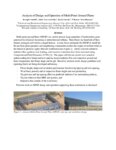TO
| Title | Date | Subject | Description | ||
|---|---|---|---|---|---|
| 201 |
 |
An evaluation of triple quadrupole ms/ms for on-line analyses of trace sulfur compounds from oil shale processing | 1985 | In order to effectively reduce sulfur gas content from shale processing to environmentally acceptable levels, H2S, COS, S02 and CH3SH plus trace sulfur compounds must be removed. Of these, the trace sulfur compounds have not been well characterized but should be known to ppm levels In order to optim... | |
| 202 |
 |
An experimental study on the thermal decomposition of catechol | 2002 | Thermal Decomposition; Catechol; Polycyclic aromatic hydrocarbons; PAH; Pyrolysis; ortho-dihydroxybenzene; Phenol decomposition; biomass; coal; wood; Kinetic model; Pyrolytic catechol decomposition; PAH formation and growth | In order to better elucidate the role of thermal decomposition products in the formation of polycyclic aromatic hydrocarbons (PAH) from complex fuels, we have performed pyrolysis experiments in a tubularflow reactor, using the model fuel catechol (ortho-dihydroxybenzene), a phenol-type compound repr... |
| 203 |
 |
An industrial development information system for Utah | 1969-12 | ||
| 204 |
 |
An overview of the Chinese UCG program | 2007-08-11 | Coal; China; Underground Coal Gasification; UCG; Two-stage gasification; Chinese UCG program; Energy | Coal is the dominant source of energy in China, but about 50% of the coal resource is left underground unmined. Because of this, the "long-tunnel, large section, two-stage" Underground Coal Gasification (UCG) technology has been put forward, and the UCG model platform has been built. Simulation test... |
| 205 |
 |
Analyses of oil extracted from oil-impregnated sandstone deposits in Utah | 1972-01 | This study, in progress from 1967 to 1970, is part of a systematic effort to find, map and sample Utah's oil-impregnated rock deposits. Samples were collected by ten individuals in field parties who examined oil-impregnated rock occurrences throughout the state. Samples 68-3A and 68-4A are from aban... | |
| 206 |
 |
Analysis of burner operation inside an enclosed ground flare | 2022 | Thermo-Acoustic Coupling; Enclosed Flare; LES CFD Model; Noise; Premixed Burner | An industrial enclosed ground flare used as part of a large refinery project has been analyzed to assess combustion stability and performance under low and high flow conditions. This flare includes a large combustion chamber directly above the burner deck with Low Flow (LF) burners that fire up to 9... |
| 207 |
 |
Analysis of crude shale oil | 1952-08 | A laboratory method for examining crude shale oil is described. The method uses only about 500 ml. of sample and a limited number of analytical determinations. Results provide information on the general characteristics and composition of an oil and serve as a basis for comparing different oils. Howe... | |
| 208 |
 |
Analysis of design and operation of multi-point ground flares | 2022 | Multi-point ground flares (MPGF) are used to process large quantities of hydrocarbon gases generated in chemical processing or petrochemical refining. These flares use hundreds of flare burners arranged and fired in a staged fashion. A wind fence surrounds the MPGF to shield the flames from plant op... | |
| 209 |
 |
Analysis of lacustrine deltaic sedimentation in the Green River Formation, southern Uinta Basin, Utah | 1991 | lacustrine deltaic sedimentation; Green River Formation; southern Uinta Basin; sedimentation analysis | Detailed lithofacies analysis of over 4,500 m of measured sections of most of the Eocene portion of the fluvial and lacustrine Green River Formation in the south-central Uinta Basin documents twelve lithofacies: Sa (nonsinuous trunk streams), Sb (meandering delta distributary channels), Sc (amalgama... |
| 210 |
 |
Analysis of oil shale and petroleum source rock pyrolysis by triple quadrupole mass spectrometry: Comparisons of gas evolution at the heating rate of 10 °C/min | 1990-10-05 | Kimmeridge; Phosphoria; La Luna; Teistberget; New Albany; Eastern U.S. Devonian; Janusfjellet; Wenzen; Maoming; Fushun; Woodford; Green River; Brotherson; Oil shale; Petroleum; Rock pyrolysis; Gas evolution; Programmed-temperature pyrolysis; Triple-quadrupole mass spectrometry; Mineral matrix; Miner... | Kimmeridge, Phosphoria, La Luna, Teistberget, New Albany, Janusfjellet, Wenzen, Maoming, Fushun, Woodford, and three Green River oil shales were subjected to programmed-temperature pyrolysis at a heating rate of 10 °C/min using triple-quadrupole mass spectrometry as the detection method. Volatile c... |
| 211 |
 |
Annual Report: University of Utah Staff Advisory Committee (UUSAC), 2013-2014 | 2014 | Annual report | Annual report of the University of Utah Staff Advisory Committee for the 2013-2014 fiscal year. The contents include the Development Committee, Legislative Committee, Events Committee, Communications & Selections Committee and the Executive Board & Committee Chairs. |
| 212 |
 |
Anxiety levels of psychiatric patients during hospitalization and at time of discharge. | 1964-06 | Mentally Ill; Anxiety | This study was made to determine (a) if there is a significant difference between anxiety levels of psychiatric patients at a midway point in their hospitalization and at the time of their discharge, and (b) is extra-hospital factors such as illness, employment status, or follow-up care influence an... |
| 213 |
 |
Apparatus and method for recovery of bituminous products from tar sands | 1978-06-20 | An apparatus and method for (1) reducing agglomerated masses of tar sand and (2) recovering as a bituminous product the bituminous matrix material therefrom. The apparatus includes a vessel which is divided into an attrition zone enclosed by a screen member, a sand separation zone and a product reco... | |
| 214 |
 |
Apparatus for extracting bitumen from tar sand | 1982-01-19 | Patent; Extracting bitumen from tar sand; Extraction chambers; Countercurrent flow; Plurality; Individually sealed pressure adjusted interconnected extraction chambers in series; Tar sand; Bitumen | A method and apparatus for extracting bitumen from tar sand utilizes a plurality of individually sealed pressure adjusted interconnected extraction chambers in which the tar sand flows countercurrent to the flow of solvent with mixing in each extraction chamber of solvent and tar sand. Tar sand is p... |
| 215 |
 |
Apparatus for separating organic material from particulate tar sands and coal and agglomeration of the particulate residue | 1976-10-05 | Patent; Tar sands; Coal; Agglomeration of particle residue; Agglomerating liquid; Immiscible; Varsol; Ball agglomerates | A rotatable drum having an interior which tapers in a horizontal direction has a first port at the smaller end for receiving particulate Tar Sands or coal, and an agglomerating liquid, e.g. water, and a second port at the larger end for receiving an organic material separating liquid, e.g. Varsol, w... |
| 216 |
 |
Apparatus for the treatment of tar sand froth | 1976-07-06 | Patent; Tar Sand Froth; Improved recycling disc-type centrifuge; Converting flow direction; Recycled underflow | An improved disc recycling type of centrifuge apparatus which includes means for converting the flow direction of the recycled underflow and causing the recycled underflow to self impact. |
| 217 |
 |
Appendix 1: User guide for characterizing particulate matter | 2003-09 | Air quality; Particulate matter; PM; Characterizing particulate matter; Sampling PM; PM background; Photoacoustic analyzer; PA; Photoelectric Aerosol Sensor; PAS; PAH; Aerosol time-of-flight mass spectrometer; ATOFMS; Dilution and Sampling; Soil; Dust; Smoke; Liquid droplets; Atmosphere; Nitrate; Su... | This User's Guide is intended to assist environmental or military personnel who work with air quality measurements, regulations, and planning for the Department of Defense. Specifically, it focuses on an evaluation of three newly developed instruments for characterizing particulate matter (PM), gene... |
| 218 |
 |
Application of a self-adaptive detector system on a triple quadrupole ms/ms to high explosives and sulfur-containing pyrolysis gases from oil shale | 1983-12 | A totally computerized triple quadrupole MS/MS is being extended into a dynamic, self-adaptive chemical analysis system at Lawrence Livermore National Laboratory. These first efforts toward Artificial Intelligence guided instrumentation (i.e. Expert Systems) involve the implementation of a self-adap... | |
| 219 |
 |
Appraisal of the technical and economic potential of U.S. tar sands | 1986-11 | U.S. tar sands constitute a large, essentially undeveloped resource that could, with technological advances. provide an important source for future liquid supplies of petroleum. The identified resource base, as reported in the update to the 19B3 report by the Interstate Oil Compact Commission (IDCC)... | |
| 220 |
 |
Areawide and local effects of tar sands development at the Sunnyside site in Utah: A socioeconomic analysis | 1984-04 | The Combined Hydrocarbon Leasing Act of 1982 (Public Law 97-78) provides guidelines for converting federal oil and gas leases to combined hydrocarbon leases in Special Tar Sands Areas (STSAs). The STSAs are designated by the U.S. Department of the Interior as areas that contain substantial deposits ... | |
| 221 |
 |
Arrangement for recovering viscous petroleum from thick tar sand | 1977-05-03 | Patent; Viscous oil; Tar sand; Petroleum; Recovering viscous petroleum; Large vertical dimension; Tubular member | An arrangement is provided for recovering viscous oil from a tar sand formation having a large vertical dimension including a substantially vertical lined shaft extending through the tar sand formation. A first opening is formed in the lower portion of the shaft lining and at least one lateral hole ... |
| 222 |
 |
Asphalt Wash 1 (U086) - Plate 9 | 2014 | Green River Formation; well log; core log; Asphalt Wash 1; plate 9 | |
| 223 |
 |
Asphalt Wash 1 XRF depth plots | 2014 | Asphalt Wash; depth plots | |
| 224 |
 |
Asphalt from Utah tar sands -- A JWBA project sponsored by the U.S. Department of Energy | 1989 | asphalt; Utah tar sands; JWBA project; asphalt production | JWBA has initiated a project for development of Utah's tar sands for production of specification-grade asphalt. Projected prices and costs strongly indicate economic viability within the market limitations. JWBA has licensed the water extraction technology developed at the University of Utah and has... |
| 225 |
 |
Asphaltene rejection from bitumens via supercritical fluid extraction | 1993 | asphaltene rejection; bitumen; supercritical fluid extraction; SFE; asphaltene content | Supercritical fluid extraction (SFE) of bitumen was carried out in a continuous extractor using propane as the solvent at several temperatures and pressures. The asphaltene contents of the residual fractions in the extractor were compared to the asphaltene content of the original bitumen. Asphaltene... |
